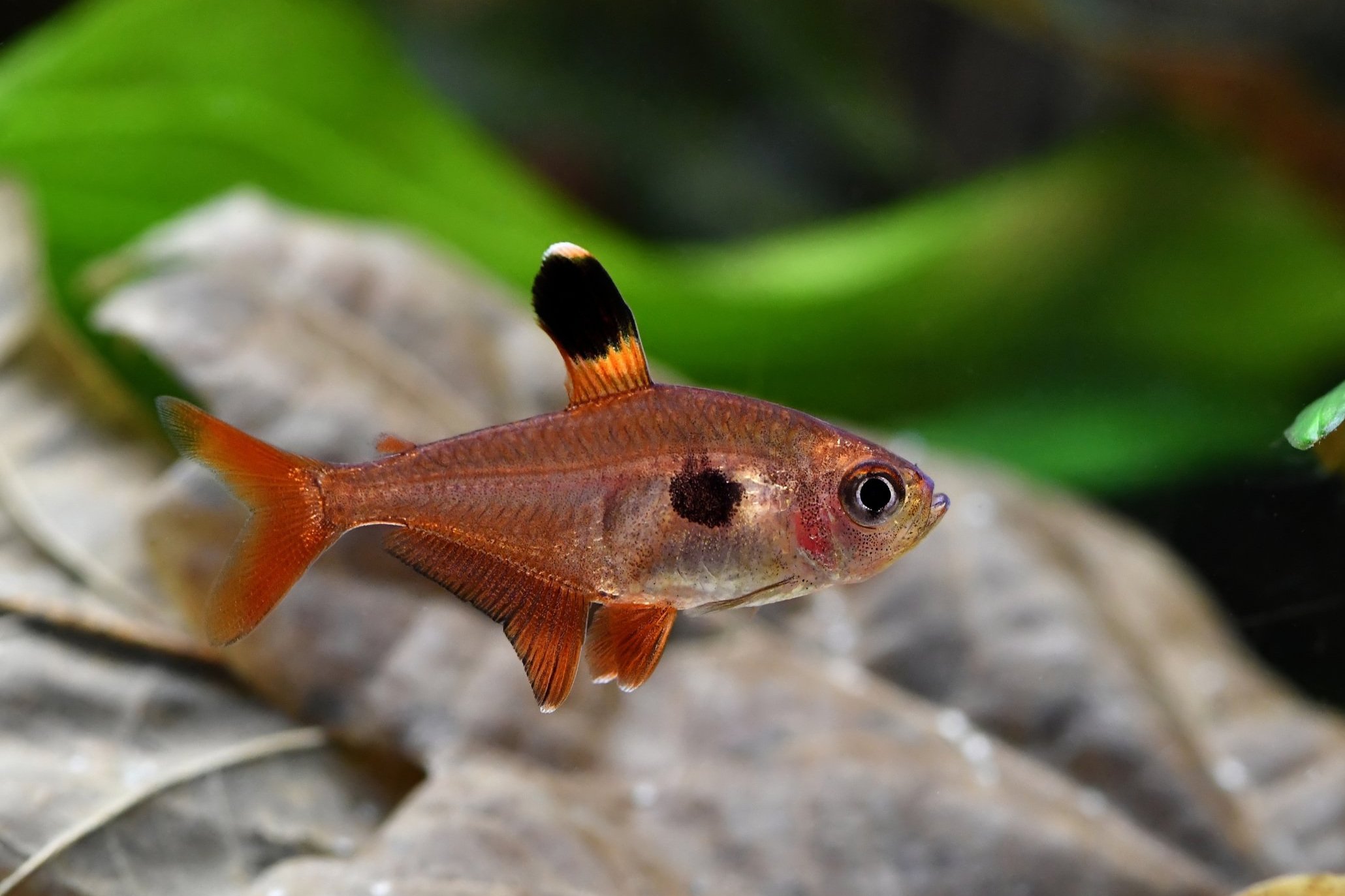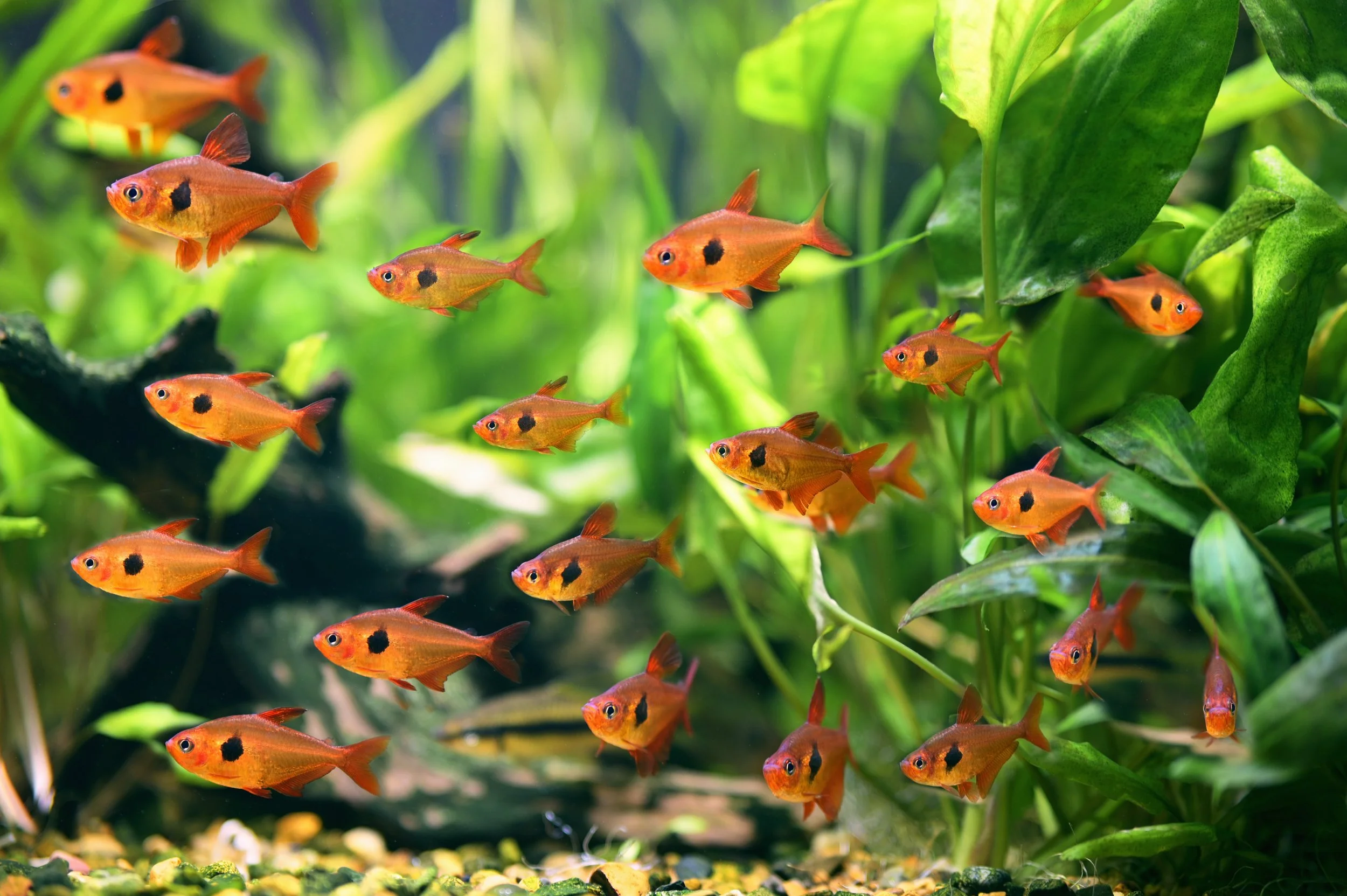 Image 1 of 3
Image 1 of 3

 Image 2 of 3
Image 2 of 3

 Image 3 of 3
Image 3 of 3




Costae Tetra
The Costae Tetra, scientifically known as Moenkhausia costae, is a captivating freshwater fish native to the São Francisco and Itapicuru rivers in Brazil. This species is appreciated for its active schooling behavior and distinctive appearance, making it a desirable addition to well-maintained community aquariums.
Physically, Moenkhausia costae features a semi-translucent silvery to green sheen on its body, with transparent fins. A notable characteristic is the black line that runs diagonally through the caudal and anal fins, adding a touch of elegance to its appearance. Adults typically reach a size of up to 7 cm in standard length.
In the aquarium, Costae Tetras thrive in well-planted tanks that offer plenty of swimming space. A tank of at least 20 gallons is recommended for a small group, with a fine gravel or sandy substrate to mimic their natural environment. Incorporating driftwood and rocks can provide additional hiding spots and help simulate their natural habitat.
Water parameters should be maintained with a temperature range of 72 to 82°F (22 to 28°C), a pH of 6.0 to 7.5, and water hardness between 2 to 15 dGH. Regular water changes and efficient filtration are essential to keep the environment clean and stable.
Feeding Costae Tetras is straightforward, as they are omnivorous and will accept a variety of foods. A balanced diet can include high-quality flake food, micro pellets, and live or frozen foods such as brine shrimp, daphnia, and bloodworms. Offering a diverse diet will help maintain their health and vibrant coloration.
Costae Tetras are social fish that should be kept in groups of at least six to promote natural behavior and reduce stress. They are suitable for community tanks with other small, peaceful species such as other South American characins and bottom-dwelling fish. However, it’s advisable to avoid housing them with species that have elaborate finnage, as Costae Tetras may display some nipping behavior.
Breeding Moenkhausia costae in captivity is possible under appropriate conditions. They are egg scatterers and do not exhibit parental care. To encourage spawning, provide a separate breeding tank with soft, slightly acidic water and fine-leaved plants for egg deposition. After spawning, it’s advisable to remove the adults to prevent them from consuming the eggs. Eggs typically hatch within a few days, and the fry can be fed infusoria or other microscopic foods until they are large enough to accept brine shrimp nauplii or finely crushed flake food.
Overall, Moenkhausia costae (Costae Tetra) is a lively and attractive species that adds movement and interest to freshwater aquariums. Their active schooling behavior, peaceful nature, and manageable size make them an excellent choice for aquarists seeking to enhance their community tank with a distinctive and harmonious species.
The Costae Tetra, scientifically known as Moenkhausia costae, is a captivating freshwater fish native to the São Francisco and Itapicuru rivers in Brazil. This species is appreciated for its active schooling behavior and distinctive appearance, making it a desirable addition to well-maintained community aquariums.
Physically, Moenkhausia costae features a semi-translucent silvery to green sheen on its body, with transparent fins. A notable characteristic is the black line that runs diagonally through the caudal and anal fins, adding a touch of elegance to its appearance. Adults typically reach a size of up to 7 cm in standard length.
In the aquarium, Costae Tetras thrive in well-planted tanks that offer plenty of swimming space. A tank of at least 20 gallons is recommended for a small group, with a fine gravel or sandy substrate to mimic their natural environment. Incorporating driftwood and rocks can provide additional hiding spots and help simulate their natural habitat.
Water parameters should be maintained with a temperature range of 72 to 82°F (22 to 28°C), a pH of 6.0 to 7.5, and water hardness between 2 to 15 dGH. Regular water changes and efficient filtration are essential to keep the environment clean and stable.
Feeding Costae Tetras is straightforward, as they are omnivorous and will accept a variety of foods. A balanced diet can include high-quality flake food, micro pellets, and live or frozen foods such as brine shrimp, daphnia, and bloodworms. Offering a diverse diet will help maintain their health and vibrant coloration.
Costae Tetras are social fish that should be kept in groups of at least six to promote natural behavior and reduce stress. They are suitable for community tanks with other small, peaceful species such as other South American characins and bottom-dwelling fish. However, it’s advisable to avoid housing them with species that have elaborate finnage, as Costae Tetras may display some nipping behavior.
Breeding Moenkhausia costae in captivity is possible under appropriate conditions. They are egg scatterers and do not exhibit parental care. To encourage spawning, provide a separate breeding tank with soft, slightly acidic water and fine-leaved plants for egg deposition. After spawning, it’s advisable to remove the adults to prevent them from consuming the eggs. Eggs typically hatch within a few days, and the fry can be fed infusoria or other microscopic foods until they are large enough to accept brine shrimp nauplii or finely crushed flake food.
Overall, Moenkhausia costae (Costae Tetra) is a lively and attractive species that adds movement and interest to freshwater aquariums. Their active schooling behavior, peaceful nature, and manageable size make them an excellent choice for aquarists seeking to enhance their community tank with a distinctive and harmonious species.
The Costae Tetra, scientifically known as Moenkhausia costae, is a captivating freshwater fish native to the São Francisco and Itapicuru rivers in Brazil. This species is appreciated for its active schooling behavior and distinctive appearance, making it a desirable addition to well-maintained community aquariums.
Physically, Moenkhausia costae features a semi-translucent silvery to green sheen on its body, with transparent fins. A notable characteristic is the black line that runs diagonally through the caudal and anal fins, adding a touch of elegance to its appearance. Adults typically reach a size of up to 7 cm in standard length.
In the aquarium, Costae Tetras thrive in well-planted tanks that offer plenty of swimming space. A tank of at least 20 gallons is recommended for a small group, with a fine gravel or sandy substrate to mimic their natural environment. Incorporating driftwood and rocks can provide additional hiding spots and help simulate their natural habitat.
Water parameters should be maintained with a temperature range of 72 to 82°F (22 to 28°C), a pH of 6.0 to 7.5, and water hardness between 2 to 15 dGH. Regular water changes and efficient filtration are essential to keep the environment clean and stable.
Feeding Costae Tetras is straightforward, as they are omnivorous and will accept a variety of foods. A balanced diet can include high-quality flake food, micro pellets, and live or frozen foods such as brine shrimp, daphnia, and bloodworms. Offering a diverse diet will help maintain their health and vibrant coloration.
Costae Tetras are social fish that should be kept in groups of at least six to promote natural behavior and reduce stress. They are suitable for community tanks with other small, peaceful species such as other South American characins and bottom-dwelling fish. However, it’s advisable to avoid housing them with species that have elaborate finnage, as Costae Tetras may display some nipping behavior.
Breeding Moenkhausia costae in captivity is possible under appropriate conditions. They are egg scatterers and do not exhibit parental care. To encourage spawning, provide a separate breeding tank with soft, slightly acidic water and fine-leaved plants for egg deposition. After spawning, it’s advisable to remove the adults to prevent them from consuming the eggs. Eggs typically hatch within a few days, and the fry can be fed infusoria or other microscopic foods until they are large enough to accept brine shrimp nauplii or finely crushed flake food.
Overall, Moenkhausia costae (Costae Tetra) is a lively and attractive species that adds movement and interest to freshwater aquariums. Their active schooling behavior, peaceful nature, and manageable size make them an excellent choice for aquarists seeking to enhance their community tank with a distinctive and harmonious species.





